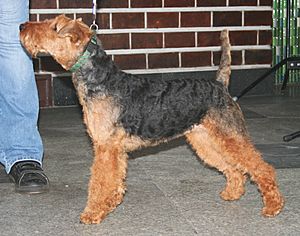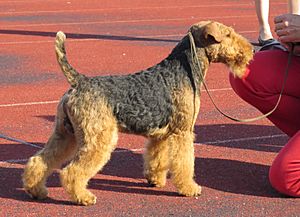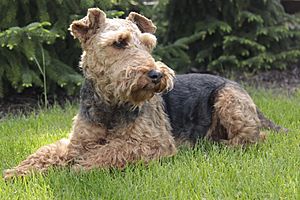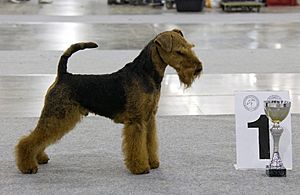Welsh Terrier facts for kids
 |
||||||||
| Common nicknames | Welshie WT |
|||||||
|---|---|---|---|---|---|---|---|---|
| Origin | Wales | |||||||
|
||||||||
| Domestic dog (Canis lupus familiaris) | ||||||||
The Welsh Terrier (called Daeargi Cymreig in Welsh) is a dog breed that comes from Wales. These dogs were first bred to hunt animals like foxes, rodents, and badgers. However, over the last 100 years, they have mostly been bred for dog shows. Even so, they still have their strong terrier personality! Some people believe the Welsh Terrier is the oldest dog breed still existing in the UK.
The Welsh Terrier was not shown in British dog shows until later. This is because they were mainly working dogs. They were not officially recognized as a breed until the 1800s. Today, the UK Kennel Club lists them as a breed that might be disappearing. Only about 300 Welsh Terrier puppies are registered each year. In comparison, the most popular dog breeds have tens of thousands of puppies registered annually.
Contents
About the Welsh Terrier
What They Look Like

Welsh Terriers have tan fur on their heads, legs, and bellies. Their backs are black or sometimes a mix of black and grey. Female Welsh Terriers can sometimes be a darker tan all over. This breed is strong and compact, meaning they are well-built and not too big.
They can grow up to 15.5 inches (39 cm) tall. They usually weigh between 20 and 22 pounds (9.1 to 10.0 kg). In the past, their tails were often shortened, or "docked." This made them look more square. However, tail docking was banned in the United Kingdom in 2006.
Welsh Terriers have a rectangular body shape. Their face looks long and "brick-like" because of their whiskers and beard. Dogs with a purebred background might have a more oval-shaped face.
Their fur has two layers. The soft undercoat keeps them warm. The rougher top coat protects them from dirt, rain, and wind. Welsh Terriers are born mostly black. During their first year, their fur changes to the standard black and tan colors.
This breed does not shed much hair. However, their coat needs regular care. This includes brushing and a special process called hand stripping. This helps remove old hairs. An un-groomed coat can lose its color and become thin.
A Welsh Terrier's tail that has not been docked is only slightly longer than a docked one. It does not change their overall look much. If their coat is not regularly groomed, old hairs will eventually fall out during play.
The Welsh Terrier looks a lot like a smaller, more compact Airedale Terrier.
Their Personality
Welsh Terriers have a typical terrier personality. If they are trained well, they are happy and lively dogs. They are rarely shy or afraid. However, they can sometimes have a strong will!
Welsh Terriers are usually friendly with people and other dogs. But if they feel challenged, they will stand their ground. These dogs can be very loyal friends. They can live happily in the city or in the countryside.
Welsh Terriers were bred to hunt on their own. This means they are very confident and brave dogs. Because of this, training a Welsh Terrier takes a lot of time and effort. You need to keep working on their training and reminding them of what they've learned.
In a book called The Intelligence of Dogs by Stanley Coren, Welsh Terriers are ranked 101st. This means they have average working and obedience intelligence. This does not mean they cannot learn commands. It just means they like to make their own choices! That's why constant training is so important. When they do act on their own, they are very creative and quick thinkers. They can also bark a lot. Like other terrier breeds, Welsh Terriers love to dig.
A Welsh Terrier has lots of energy and needs regular exercise. Just running around the yard is not enough. If they get bored, they might explore and cause trouble or damage. Welsh Terriers need challenges to keep them busy. For example, they love chasing toys and swimming. They enjoy lake activities with their families.
Welsh Terriers usually get along well with children. They love to play and follow kids around. Sometimes, they might tug on pant legs or accidentally knock over young children. If they are around young children from an early age, they will learn to play more gently.
Like all dog breeds, it is important to help Welsh Terriers meet many different dogs, people, and experiences when they are young. This is called socialization.
Welsh Terrier Health
The Welsh Terrier is generally a healthy and strong dog. They have a durable body. Some studies suggest they might be more likely to get a certain eye problem called primary lens luxation. This can lead to another eye condition called glaucoma.
Another common issue in this breed is onychodystrophy. This is a problem with nail growth that makes their nails weak and brittle. A healthy Welsh Terrier usually lives for about 12 to 13 years. They can stay active and alert into old age if they are well cared for.
Famous Welsh Terriers
- Charlie, who was the pet of John F. Kennedy, a former US President.
- A Welsh Terrier owned by Clement Attlee, who was the Prime Minister of the United Kingdom from 1945 to 1951. This dog is even shown on Earl Attlee's family crest!
- Gwen, a Welsh Terrier who was the pet of Edward, Prince of Wales. He later became King Edward VIII.
See also
 In Spanish: Terrier galés para niños
In Spanish: Terrier galés para niños



